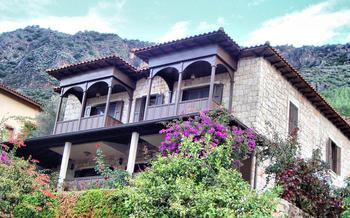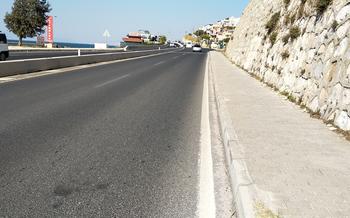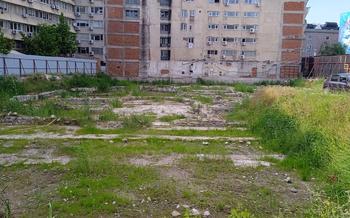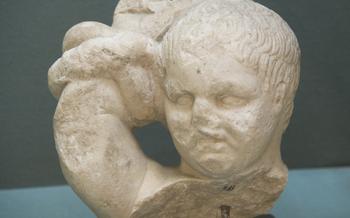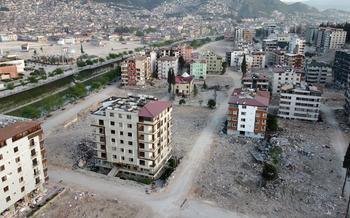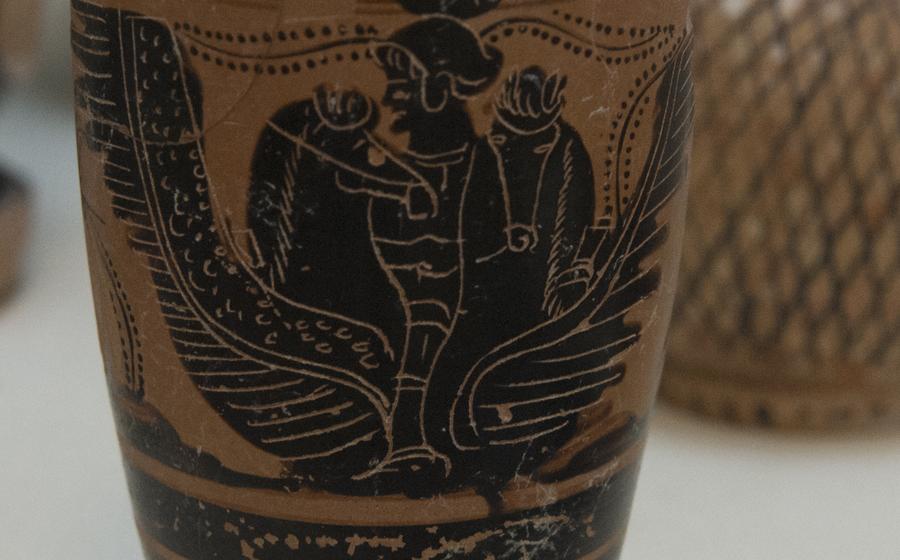
Silifke Museum
- Historical Background
- Location and Accessibility
- Museum Collections
- Archaeological Findings
- Mosaics and Frescoes
- Ancient Coins:
- Ceramics and Pottery:
- Sculptures and Statues
- Jewelry and Ornaments:
- Tools and Implements
- Religious Artifacts
- Interactive Exhibits
- Guided Tours and Workshops
- Museum Amenities
- Insider Tip
Historical Background
Silifke, located in the Mersin province of Turkey, boasts a rich and diverse history that dates back to ancient times. The region served as a critical crossroads for various civilizations, including the Hittites, Persians, Greeks, Romans, and Byzantines, each leaving their unique imprint on the cultural tapestry of Silifke. The establishment of the Silifke Museum serves as a testament to the significance of this historical heritage, preserving and showcasing the relics and artifacts that provide glimpses into Silifke's fascinating past.
Silifke, strategically situated along the Mediterranean coast, played a vital role in trade and commerce throughout history. During the Hellenistic period, it was known as Seleucia and served as a major port city for the Seleucid Empire. The city's strategic location continued to be of importance during the Roman and Byzantine eras, when it became a significant center for Christian culture and administration.
In the 7th century AD, the region came under the rule of the Arab Caliphate, marking the beginning of a new chapter in its history. The Islamic influence brought about significant cultural and architectural changes, reflected in the construction of mosques and the introduction of Arabic as the official language.
Location and Accessibility
The Silifke Museum is conveniently located in the heart of Silifke, a charming town on the Mediterranean coast of Turkey. It is situated within walking distance of the town center and is easily accessible by public transportation. Visitors can take a bus or a taxi from Mersin or Adana, the two largest cities in the region. The museum is also well-connected by road, making it a popular destination for road trippers exploring the Turkish Riviera. To avoid crowds, it is advisable to visit during the shoulder seasons (spring or autumn) when the weather is still pleasant but there are fewer tourists.
Museum Collections
The Silifke Museum boasts a diverse range of artifacts and exhibits that provide a glimpse into the rich history and culture of the region. Among the highlights of the collection are exquisite mosaics and frescoes, ancient coins, ceramics and pottery, sculptures and statues, jewelry and ornaments, tools and implements, and religious artifacts.
The museum's collection of mosaics and frescoes is particularly noteworthy, showcasing the artistry and craftsmanship of ancient craftsmen. These intricate artworks depict various scenes from mythology, history, and daily life, offering valuable insights into the beliefs and customs of past civilizations.
The numismatic collection features a variety of ancient coins, each with its own unique story to tell. These coins provide a glimpse into the economic and political systems of the region, as well as the trade and commerce that took place in ancient times.
The museum also houses a diverse collection of ceramics and pottery, representing different periods and styles. These artifacts showcase the skill and artistry of local potters, as well as the various techniques and decorative motifs used throughout history.
In addition to these highlights, the museum also displays a collection of sculptures and statues, providing a glimpse into the artistic and cultural influences of the region. These works of art depict various deities, heroes, and historical figures, offering insights into the religious and cultural beliefs of the past.
Archaeological Findings
Silifke and its surroundings have been a treasure trove for archaeologists, yielding significant discoveries that have shed light on ancient civilizations. Excavations conducted in the region have unearthed remarkable artifacts, including pottery, tools, jewelry, and sculptures, providing valuable insights into the daily lives, cultural practices, and artistic traditions of past inhabitants. These findings have contributed to our understanding of the region's rich history, from the Neolithic period to the Roman and Byzantine eras.
One of the most notable archaeological discoveries in Silifke is the ancient city of Olba, located approximately 20 kilometers from the city center. Excavations at Olba have revealed the remains of a well-preserved theater, temples, and other public buildings, offering a glimpse into the urban life of the ancient city. Another significant discovery is the necropolis of Uzuncaburç, which contains over 1,000 rock-cut tombs dating back to the Hellenistic and Roman periods. These tombs provide valuable information about burial customs and funerary practices in the region.
The Silifke Museum plays a crucial role in preserving and studying these archaeological findings. The museum houses a vast collection of artifacts unearthed during excavations, allowing visitors to explore the rich cultural heritage of the region. Through its exhibits and displays, the museum provides a comprehensive overview of the archaeological discoveries made in Silifke and the surrounding area, offering visitors a deeper understanding of the ancient civilizations that once thrived in this part of Turkey.
Mosaics and Frescoes
The Silifke Museum is home to an exquisite collection of mosaics and frescoes that offer a glimpse into the artistic traditions of ancient civilizations in the region. These intricate artworks, created using colorful tesserae or pigments, depict a variety of subjects, from mythological scenes to everyday life.
One of the most notable mosaics is a beautiful depiction of the goddess Leda and the swan, a popular motif in Greek mythology. The mosaic showcases the artist's skill in capturing the graceful movements and delicate features of the figures. Another highlight is a mosaic depicting a hunting scene, with hunters pursuing various animals amidst a lush forest landscape.
The museum also houses a collection of stunning frescoes, painted directly onto the walls or ceilings of ancient buildings. These frescoes feature vibrant colors and intricate designs, portraying religious scenes, historical events, and mythological tales. One particularly impressive fresco depicts a procession of musicians and dancers, capturing the festive spirit of ancient celebrations.
The mosaics and frescoes at the Silifke Museum provide a unique opportunity to admire the artistic achievements of ancient artisans and gain insights into the cultural and religious beliefs of past civilizations. The museum's dedication to preserving and showcasing these delicate works of art ensures that visitors can continue to appreciate and learn from these remarkable treasures.
Ancient Coins:
The Silifke Museum houses a remarkable numismatic collection that offers a glimpse into the monetary systems and economic activities of ancient civilizations in the region. These coins, minted from various metals such as gold, silver, and bronze, bear intricate designs and inscriptions that provide valuable insights into the political, economic, and cultural history of the area.
Some of the most notable coins on display include rare and well-preserved examples from the Hellenistic, Roman, and Byzantine periods. Visitors can marvel at the artistry and craftsmanship of these ancient coins, which often feature portraits of rulers, deities, or mythological figures.
The museum also showcases a collection of Islamic coins, minted during the Umayyad, Abbasid, and Ottoman periods. These coins provide evidence of the region's trade and commercial interactions with the wider Islamic world and offer insights into the economic and political developments of the time.
The numismatic collection at the Silifke Museum serves as a valuable resource for researchers and scholars studying the economic history of the region. It allows visitors to explore the fascinating world of ancient coinage and gain a deeper understanding of the financial systems and trade networks that shaped the development of civilizations in Mersin and beyond.
Ceramics and Pottery:
The Silifke Museum boasts an impressive collection of ceramics and pottery that provides a glimpse into the domestic life and artistic traditions of the region's past. These artifacts showcase the diverse range of pottery produced in Silifke and its surrounding areas throughout history. Visitors can admire various types of pottery, from simple utilitarian vessels to exquisitely decorated pieces that demonstrate the skill and artistry of ancient potters.
The museum's collection includes both locally produced pottery and imported pieces from neighboring regions and beyond. These artifacts provide valuable insights into trade and cultural exchanges that took place in ancient times. The exhibits showcase a variety of decorative techniques and styles, including intricate patterns, painted designs, and relief sculptures.
By examining these ceramics and pottery, visitors can gain a deeper understanding of the daily lives of people in ancient Silifke. The collection offers a glimpse into their cooking, storage, and dining practices, as well as their artistic preferences and cultural influences.
Sculptures and Statues
The Silifke Museum is home to an impressive collection of sculptures and statues that provide a glimpse into the artistic and cultural influences of the region throughout history. These artworks, crafted from various materials such as marble, limestone, and bronze, showcase the exceptional skills and creativity of ancient artisans.
The sculptures and statues depict a wide range of subjects, including gods, goddesses, mythical creatures, and historical figures. Visitors can admire the exquisite details and intricate carvings that bring these figures to life. Some of the most notable pieces include a majestic statue of Zeus, the king of the gods, as well as a graceful statue of Aphrodite, the goddess of beauty and love.
These artworks offer valuable insights into the religious beliefs, mythology, and cultural practices of the ancient peoples who inhabited the region. They also shed light on the artistic influences and exchanges that took place between different cultures, as many of the sculptures and statues exhibit a blend of styles and techniques from both the East and the West.
By studying these sculptures and statues, visitors can gain a deeper understanding of the artistic heritage of Mersin and Silifke, and appreciate the enduring legacy of ancient civilizations that once flourished in this region.
Jewelry and Ornaments:
The Silifke Museum houses a captivating collection of jewelry and ornaments that adorned the bodies of ancient people. These exquisite pieces, crafted from precious metals like gold and silver, reflect the artistry and craftsmanship of past civilizations. From intricate necklaces and earrings to delicate bracelets and rings, the museum's collection showcases the diverse styles and designs that were popular in the region.
Visitors can admire the intricate filigree work, gemstone embellishments, and symbolic motifs that adorn these ornaments. Each piece holds stories of personal adornment, cultural identity, and social status. The jewelry on display provides insights into the fashion trends, beauty ideals, and personal expression of ancient societies.
Highlights of the collection include a stunning gold necklace adorned with colorful gemstones, a pair of intricately carved silver earrings depicting mythical creatures, and a delicate gold bracelet with intricate granulation work. These and many other pieces offer a glimpse into the lives of ancient people and their passion for personal adornment.
Tools and Implements
The Silifke Museum houses a fascinating collection of tools and implements that provide a glimpse into the daily lives of ancient people in the region. These artifacts offer valuable insights into the technological advancements and craftsmanship of past civilizations.
Among the tools on display are agricultural implements such as plowshares, sickles, and hoes, which were essential for farming and sustaining communities. There are also various carpentry tools, including saws, axes, and chisels, demonstrating the skills and techniques used by ancient carpenters to create furniture, buildings, and other wooden objects.
Visitors can also see a range of metalworking tools, such as hammers, anvils, and tongs, which were used to forge weapons, armor, and other metal objects. These tools showcase the ingenuity and expertise of ancient metalworkers, who played a crucial role in shaping and transforming metals into useful and decorative items.
The museum's collection also includes a variety of household tools and implements, such as cooking utensils, pottery, and weaving tools, which shed light on domestic life and daily routines in ancient times. These artifacts provide a tangible connection to the past, allowing visitors to imagine the daily activities and challenges faced by people who lived in the region centuries ago.
By studying and understanding the tools and implements on display at the Silifke Museum, visitors can gain a deeper appreciation for the technological advancements and craftsmanship of ancient civilizations, as well as the ingenuity and resourcefulness of the people who lived in this region throughout history.
Religious Artifacts
The Silifke Museum houses a diverse collection of religious artifacts that provide insights into the spiritual beliefs and practices of ancient peoples in the region. These artifacts span various faiths and periods, reflecting the rich religious tapestry of the area. Visitors can admire intricately carved idols, ornate altars, and votive offerings that once adorned temples and shrines. The museum's collection includes items from ancient Greek, Roman, and Christian traditions, among others. Of particular note is a rare and well-preserved statue of the goddess Athena, discovered in a nearby excavation site. This statue, with its serene expression and elaborate headdress, offers a glimpse into the religious devotion of the ancient Greeks. The museum's collection of religious artifacts not only showcases the diversity of faith in ancient Silifke but also highlights the profound influence of religion on the region's culture and society.
Interactive Exhibits
The Silifke Museum goes beyond static displays and offers a range of interactive exhibits that transform the museum experience into a dynamic and engaging journey through history. These exhibits are designed to captivate visitors of all ages, making learning about the region's past an immersive and interactive adventure.
One of the highlights is a virtual reality experience that transports visitors back in time to witness significant historical events that shaped the region. Through this immersive technology, they can explore ancient cities, attend festivals, and interact with historical figures, gaining a firsthand perspective of the past.
Other interactive elements include touchscreens with detailed information about the artifacts and the region's history, allowing visitors to delve deeper into the stories behind the exhibits. Interactive maps and timelines help visitors visualize the geographical and chronological context of the artifacts, creating a comprehensive understanding of the region's development over time.
For younger visitors, the museum offers a variety of hands-on activities that make learning about history fun and interactive. They can participate in archaeology-themed games, solve puzzles, and engage in creative workshops that allow them to express their own artistic interpretations of the past.
These interactive elements not only enhance the visitor experience but also promote a deeper understanding of the region's rich cultural heritage. They transform the museum into a dynamic space where history comes alive, inspiring curiosity, encouraging exploration, and creating lasting memories for visitors of all ages.
Guided Tours and Workshops
Visitors to the Silifke Museum can enhance their experience by booking a guided tour. These tours are led by knowledgeable experts who provide in-depth insights into the exhibits and the history of the region. Guided tours are available in various languages and can be tailored to suit the interests and needs of different groups.
The museum also offers a range of educational programs and workshops for visitors of all ages. These programs are designed to foster a deeper understanding of the exhibits and the region's history. Workshops may include hands-on activities, such as pottery making, mosaic workshops, or coin minting, allowing visitors to engage with the past in a fun and interactive way.
Guided tours and workshops are a great way to maximize your visit to the Silifke Museum. They provide opportunities to learn from experts, ask questions, and gain a deeper understanding of the region's rich history and culture. Be sure to inquire about these programs when planning your visit to the museum.
Museum Amenities
The Silifke Museum offers a range of amenities to enhance the visitor experience. A well-stocked gift shop provides a variety of souvenirs, including replicas of ancient artifacts, books on local history and culture, and traditional handicrafts. Visitors can also enjoy a break at the museum's café, which offers refreshments and light meals. For those interested in delving deeper into the region's history, a research library is available, providing access to a collection of books, journals, and archival materials. The museum is committed to accessibility, with ramps and elevators making it easy for visitors with disabilities to navigate the exhibits. Whether you're looking for a unique souvenir, a place to relax and refuel, or an opportunity to learn more about the region's rich history, the Silifke Museum has something for everyone.
Insider Tip
-
To enhance your museum experience, consider visiting during the shoulder seasons (spring or fall) to avoid large crowds and enjoy a more intimate atmosphere.
-
After exploring the museum, take some time to stroll through the charming streets of Silifke, where you'll find historic landmarks, traditional markets, and local eateries.
-
If you're interested in learning more about the region's ancient past, plan a visit to the nearby archaeological sites, such as the ancient city of Uzuncaburç or the Roman ruins of Elaiussa Sebaste.
-
Don't hesitate to engage with the museum staff, who are knowledgeable and passionate about the region's history. Ask questions, seek recommendations, and gain a deeper understanding of the exhibits and the surrounding area.


